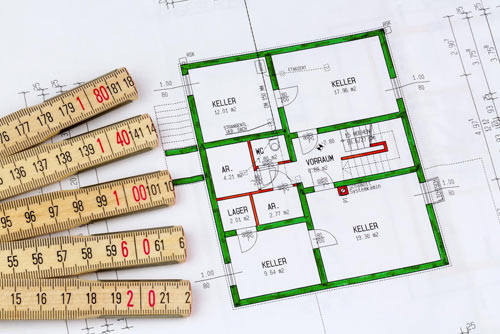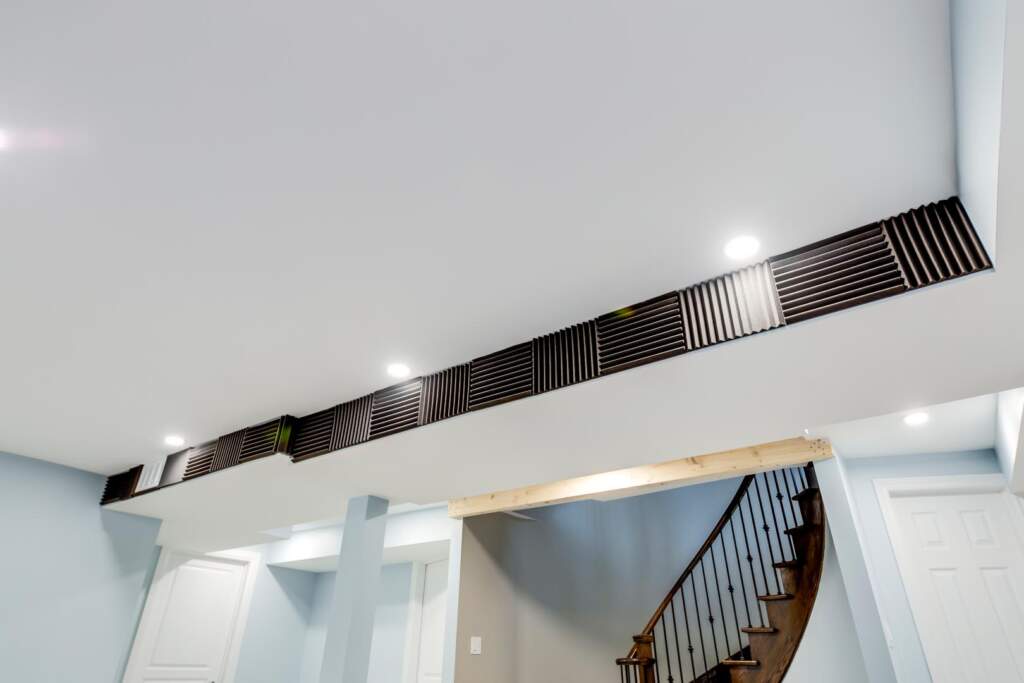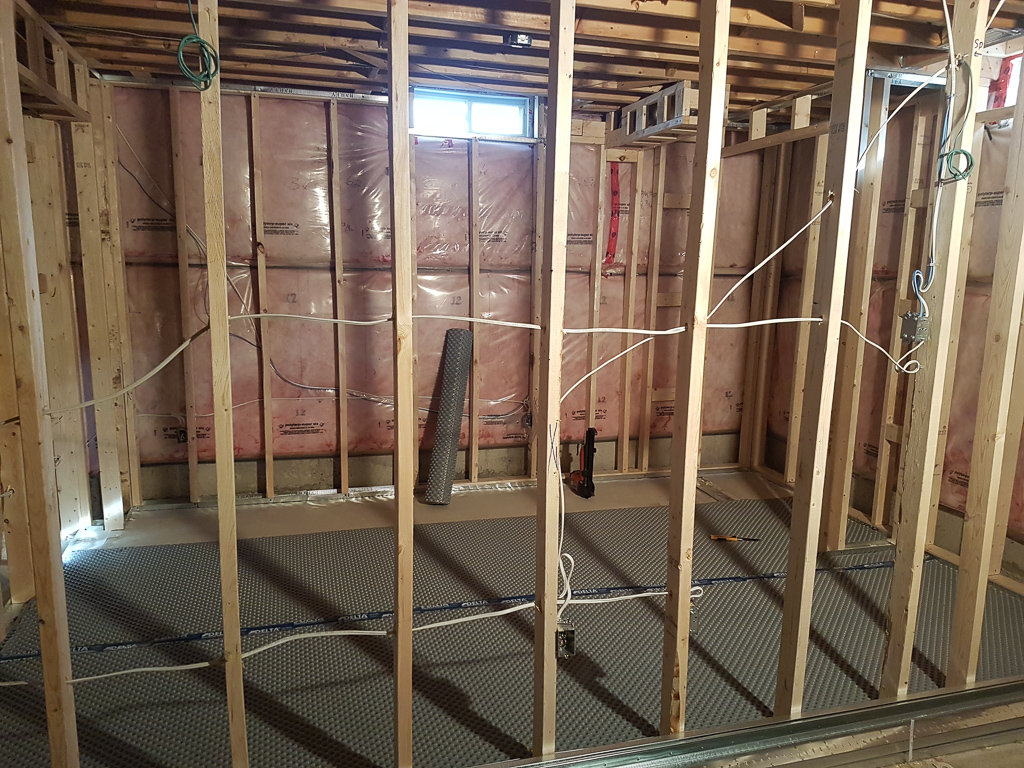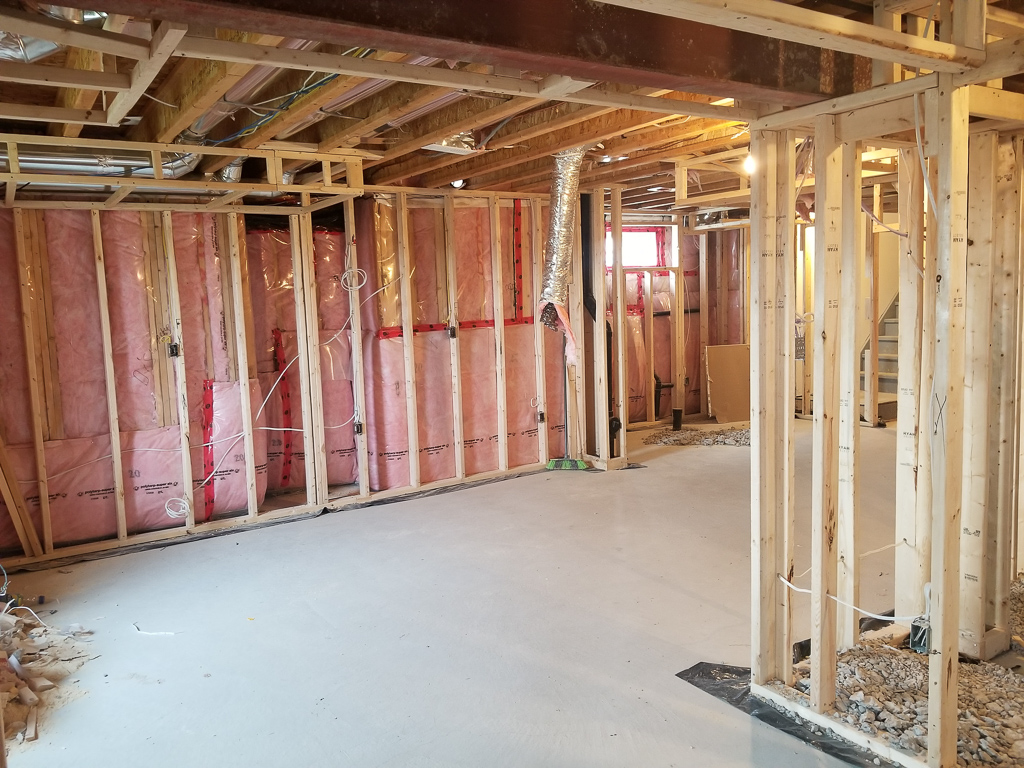
Basements with low ceilings are a common problem, especially in older homes. A low ceiling can prevent you from enjoying untapped living space and added resale value. But there is a renovation solution to increase the height of your basement ceiling and get more square footage.
In this article, the experts at Moose Basements outline basement underpinning and basement benching, which choice is right for you, as well as the pros and cons of each construction method.
Can I Raise My Basement Ceiling Height?
Yes, any homeowner can raise the ceiling height in their basement by making structural changes to the foundation. This is called lowering your basement’s foundation, and it can be done one of two ways: basement underpinning or basement benching.
There are many factors for homeowners and contractors to consider when deciding between the two methods.

What is Basement Underpinning?

The underpinning process involves digging out the basement with a trench around the perimeter of the basement. Once the foundation’s footings are exposed, we remove them, dig deeper, and install new footings at the desired depth.
After the new concrete footings have cured, the contractor can rebuild walls and lay down new flooring. Basement underpinning is a costly project that should only be handled by a certified professional, but you’ll enjoy the many benefits of a higher basement ceiling.
Why You Should Consider Underpinning
If your foundation has suffered extensive cracking or you have an older home you’d like to top up, underpinning may be your only option to upgrade the structural integrity of your home.
In some cases, the underpinning process can also prevent basement flooding and increase energy efficiency by better sealing in your hot or cold air, depending on the season.

What is Bench Footing?

Bench footing or basement benching is a more affordable and quicker way to increase the height of your basement ceiling. This method involves, again, digging a trench around the perimeter of the basement.
But rather than digging below and removing the old foundation footings, a concrete bench is built just inside the existing walls of the basement. While there’s less digging, you have to consider that you’ll be losing livable square footage because of the new ledge running around the perimeter.
Why You Should Consider Benching
Benching is for homeowners who can’t add another story to their home or live in a narrow lot and can’t put an addition on either side. If you have a lower budget and are trying to keep renovations to a minimum, bench footing is the right choice for you.
Pros and Cons of Underpinning
Pros:
- Increase structural integrity of your basement, especially if your old foundation is full of cracks.
- Get more ceiling height so your basement can reach its full potential, while increasing the amount of natural light and artificial lighting options available to you.
- Take advantage of your basement being torn down to the studs and upgrade your electrical and plumbing systems.
- More square footage in your home after lowering a basement floor means increased resale value when you go to market.
Cons:
- It’s a big project that needs a lot of labour and time to finish. The excavation is a big, messy job and can take a long time to get done.
- Underpinning in Toronto will cost tens of thousands of dollars depending on the size of the basement and desired depth.
Pros and Cons of Benching
Pros:
- A higher basement ceiling means you can more easily use your basement for entertaining guests, hosting relatives, or renting for extra cash.
- If your foundation is damaged, benching can help shore up its structural integrity.
- Installing the concrete bench can keep moisture out and reduce the possibility of flooding.
- This project is cheaper than underpinning and faster to get done.
Cons:
- The concrete ledge takes away from your overall square footage because it’s sticking out from the original interior wall.
- Bench footing does not repair your old foundation if it has cracks or other imperfections.
- Bench footing doesn’t guarantee increased property value.
Which Method is Right For You?
If you can’t decide between bench footing and basement underpinning for your basement renovation, it all depends on your home’s existing structure and what you’re trying to get out of the project.
Are you worried about losing square footage? Choose basement underpinning. Underpinning requires digging underneath the foundation, allowing you to add height with newly poured concrete footings, and keep all of your living space. Bench footing takes up valuable real estate with its concrete ledge that sticks out from the original interior walls.
Are you worried about damaging the foundation of your house? Choose benching. Bench footing is your answer because contractors just dig a new floor up to the line of your existing foundation and pour a bench, or essentially a new foundation, inside your basement. Less mess and less stress.
Do you have a shared wall with a neighbour? You might have to go with benching. Because of the invasive nature of the underpinning method, your neighbour might prevent you from using that method to lower your basement. Benching will be less intrusive and you won’t need anybody’s permission to undertake that project.
Is your foundation weak? Choose benching. If you have a heavily damaged or weakened foundation you don’t want to mess with it at all. However, bench footing doesn’t disrupt your original foundation and helps you achieve a higher basement ceiling.
Do you need something budget-friendly? Choose benching. If you have a tight budget for your home renovations, then bench footing might be the answer. There is less risk to your home’s structural integrity, fewer costs and less labour.
Sometimes the choice isn’t yours. As discussed in some of the scenarios above, other people or the existing structure of your house can dictate whether you go with underpinning or benching to strengthen your foundation and/or lower your basement.
Whether you choose benching or underpinning for basement lowering, make sure you hire a certified, insured professional like the team at Moose Basements. We provide free estimates, first-rate customer service, and expert consultation on the best renovation decisions for your home. Contact Moose Basements now to book your appointment.
The post Basement Underpinning vs. Benching appeared first on Moose Basements LTD.
https://moosebasements.ca/basement-underpinning-vs-benching/
 Backyard GrillingWeekend WarriorsAdvice from DadBeard GroomingTV Shows for Guys4x4 Off-Road CarsMens FashionSports NewsAncient Archeology World NewsPrivacy PolicyTerms And Conditions
Backyard GrillingWeekend WarriorsAdvice from DadBeard GroomingTV Shows for Guys4x4 Off-Road CarsMens FashionSports NewsAncient Archeology World NewsPrivacy PolicyTerms And Conditions
